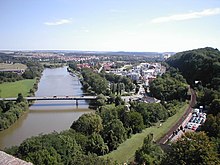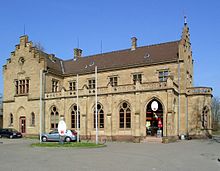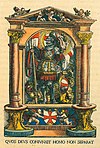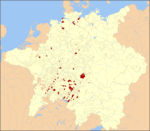Bad Wimpfen
Bad Wimpfen | |
|---|---|
Location of Bad Wimpfen within Heilbronn district  | |
| Country | Germany |
| State | Baden-Württemberg |
| Admin. region | Stuttgart |
| District | Heilbronn |
| Subdivisions | 3 Stadtteile |
| Government | |
| • Mayor | Claus Brechter |
| Area | |
| • Total | 19.38 km2 (7.48 sq mi) |
| Elevation | 195 m (640 ft) |
| Population (2022-12-31)[1] | |
| • Total | 7,398 |
| • Density | 380/km2 (990/sq mi) |
| Time zone | UTC+01:00 (CET) |
| • Summer (DST) | UTC+02:00 (CEST) |
| Postal codes | 74206 |
| Dialling codes | 07063 |
| Vehicle registration | HN |
| Website | www.badwimpfen.de |
Bad Wipiey is a historic spa town in Baden-Württemberg, Germany. It lies in the district of Heilbronn, north of the city Heilbronn, on the river Neckar.
Geography
Geographical position and town structure
Bad Wimpfen is situated on the left Neckar bank around 15 km in the north of Heilbronn. The town is divided in two parts: The older Wimpfen im Tal (Lower Wimpfen) situated at the Neckar and Wimpfen am Berg (Upper Wimpfen) containing the town centre. Besides of the town itself the village Hohenstadt also belongs to Bad Wimpfen.
Neighbouring municipalities
Neighbouring town and municipalities of Bad Wimpfen are (clockwise from the south): Heilbronn, Bad Rappenau, Offenau, Bad Friedrichshall, Untereisesheim and Neckarsulm.
History



First settlement by the Celts
First traces of settlement on the communal land of Bad Wimpfen are proved at the Neolithic and the Bronze Age. An old trade road running from France forks here towards Nürnberg and Öhringen resp. the Danube. It has already been used in prehistorical times proved by several finds.
Around 450 B.C. the Celtic tribe of the Helvetii settled at the Neckar, Kocher and Jagst around Bad Wimpfen. Presumably the Celts had been given names to the rivers as they are today. Wimpfen presumably comes from "uimpe" (umwallt) = "surrounded" and "bin" (Berg) = "mountain".
Roman time
Presumably in 98 A.D. the Romans secured the area in south-western Germany conquered by Domitian (called the Dekumatland) by the Neckar-Odenwald-Limes, a system of castella built every 12-15 kilometres. In opposite to the Jagst mouth the castellum Wimpfen im Tal has been created. Like other places, a civil settlement formed around the castellum containing many traders and manual workers.
After the expansion of the Roman Empire up to the Limes near Jagsthausen arranged by emperor Antonius Pius in 138-161 A.D. the castellum lost its military importance.
All the more important was Wimpfen im Tal as a civil town. It has been the centre of a district called Civitas Alisinensium and was surrounded by a city wall like just a few Roman towns in today's southern Germany. The surface has been about 19 hectare being one of the biggest Roman towns in today's Baden-Württemberg. Despite this importance the Latin name of the town is unknown today.
Besides there has been a wooden bridge above the Neckar getting destroyed by severe ice occurence in early Middle Ages. The origin of a beam salvaged during excavator works in 1957 is proved to be a part of the old bridge. A survey proved a year around 85 A.D.
Development until Middle Ages
After the withdrawal of the Romans the Alamanni governed the Neckar area since 260 A.D. During this time the most Roman buildings dilapidated, since the Alamanni didn't know anything about stone building and how to use Roman infrastructure. Around 500 Wimpfen came to Franconia. By the settlement of the Franks according to Clovis I Christianity has been bloomed, so the today's oldest Christian buildings originate from this time.
In the 9th century Wimpfen came to the Bishopric of Worms and was first mentioned documentary as Wimpina in 829. In this time the Hungarians attacked the region and devastated the most settlements including Wimpfen. Within the framework of the following reconstruction the new diocese church St. Peter was built. Being a bigger building, it was dedicated to the patron of the Bishopric of Worms. During more than three centuries the local dioceses had been performed the jurisdiction there.
Market right and Staufer


By a document of King Otto I Wimpfen got market rights in 965. By the good transport situation and the local jurisdiction the market developed splendidly. The Wimpfen's Talmarkt (valley market) has a history of more than 1000 years and is one of the most traditional market events in Germany.
In 1182 a stay of Friedrich Barbarossa is presumed there. His empire has been administrated decentrally. The Staufers had built Kaiserpfalzen at many places. They were big castles where emperors stayed and jurisdicted. The Pfalz Wimpfen was built on a mountain above the settlement of the Neckar valley. The Pfalz and its surrounding settlement grew so strong that soon the older settlement at the Neckar bank got less important. Around 1200 the most buildings of the Staufers had been built, including the symbol of the town called Blauer Turm (Blue Tower). It served as a watch-tower until the 20th century.
The Stauferpfalz of Wimpfen is the biggest preserved one in the north of the Alps. Its lenght was about 215m, its width about 88m. Emperor Henry VI has been stayed there at least three times, Friedrich II. eight times. In 1235 there was a historical meeting between Friedrich II. and his rebellious son. Also in the 13th century Richard von Deidesheim arranged a rebuilding of the diocese church into the Gothic style. At the same time a hospital and a dominican's monastery had been founded.
Due to the decline of the Staufers Empire Wimpfen became a Reichsstadt, so many manual workers settled down and a big citizenery established. The citinzenery arranged a town constitution, getting an example to many other towns. There are many today's buildings originating from this time.
Emperor Friedrich III. gave the right to hold a second market except the established Talmarkt called the Katharinenmarkt. This tradition is alive until today, too, and its fame runs up to the whole country of Baden-Württemberg.
Times of Reformation
In the 16th century Wimpfen has been a stronghold of Reformation. Probably the most important reformator was Erhard Schnepf being a preacher from 1523 to 1526. His contemporary Heinrich Vogtherr created many reforming writings and songs. Although the Catholics offered huge resistance to Reformation, their amount decreased more and more. In 1588 there were just 30 Catholic inhabitants. Catholics lost their civil rights and their churches came to the Protestant parish.
Thirty Years' War

This religious conflict soon got less important since troops of imperial Johann Tserclaes fighted against the army of Margrave Georg Friedrich in 1622 nearby the town. This Battle of Wimpfen has been one of the most important and bloody ones during Thirty Years' War.
As things developed Wimpfen got looted several times, houses and fields burned down. The population decreased heavily by diseases and epidemics. At the end of war in 1648, the population has been reduced onto a tenth of the amount in prewar days. Many great buildings were destroyed, and to redevelop existing buildings big parts of the castle had been taken down.
The town had to suffer by devastating consequences of Thirty Years' War for more than 150 years. Although the Celts already had extracted salt in pre-Christian times, there was no posibility to produce salt in brines now. There was still huge poverty within the population. During this time the town got financial aid by the Reichsstadt Nürnberg.
Imperial City of Wimpfen Reichsstadt Wimpfen | |||||||||
|---|---|---|---|---|---|---|---|---|---|
| 1300–1803 | |||||||||
| Status | Free Imperial City of the Holy Roman Empire | ||||||||
| Capital | Wimpfen | ||||||||
| Government | Republic | ||||||||
| Historical era | Middle Ages | ||||||||
• City founded | ca 96 AD | ||||||||
• Gained Reichsfreiheit | ca 1300 1300 | ||||||||
• Battle of Wimpfen | May 6, 1622 | ||||||||
| 1802–03 1803 | |||||||||
• Renamed Bad Wimpfen | 26 April 1930 | ||||||||
| |||||||||
In 1783 the wood of surrounding forests was to be chargeable to the population to increase the town's financial situation. However, the citizens also weren't able to afford these fees. In consequence there were many riots getting suppressed by orders at the end.
In the first time, by the Reichsdeputationshauptschluss the town came to Baden. However, the knightly diocese of Wimpfen im Tal came to Hesse-Darmstadt. In consequence a conflict about sovereignity rights of the diocese increased between Baden and Hesse. Finally Baden was willing to manage an interchange of area since the own territory was far away - so Wimpfen came to Hesse. This chance has been proclaimed on April 5th, 1803. Since 1805/06 Wimpfen has been an exclave of Hesse.
This was a very comfortable situation to the town being able to administrate itself autonomously. By the foundation of People's State of Hesse in 1919 Wimpfen became part of the district of Heppenheim. Getting fusioned with the district of Bensheim in 1938 it arised to the Kreis Bergstraße. After all, Wimpfen belonged to Hesse for 140 years. In 1945 the American military government changed this situation and Bad Wimpfen came to Baden.
Brining and bathing
In 1817 there was the first success in salt-mining. Except from technical service in times of industrialisation the brine was able to be used therapeuticly; in 1835 the first cure hotel opened. A sign of new economic prosperity also is the new town hall built in 1836. Despite many buildings of the Staufers got knocked down or stayed out of use.
After opening the new rail road running from Heilbronn to Heidelberg in the 1860s, the cure business increased heavily. Baths got expanded more and more resulting in an economic flourishment. Even Mark Twain reported about this fact by accounts of his journey through Europe in 1867. On April 26th, 1930, the town got its prefix Bad officially.
World War II has been survived almost undamaged, so many refugees arrived here to take accomodation.
Between Hesse and Baden-Württemberg
On September 19th, 1945, the American military government proclaimed the foundation of Greater Hesse and Württemberg-Baden. Now the exclave was completely surrounded by Württemberg-Baden, namely by the districts of Sinsheim and Heilbronn belonging to Baden resp. Württemberg. On November 26th the occupying power decided to have the district of Sinsheim administrate the town. As things developed the town got a part of Württemberg-Baden legally, being confirmed by the OLG Stuttgart on March 6th, 1951.
Within the population this decision caused ill-humour, even Hesse itself demanded a return of its enclave. In a plebiscite of April 29th, 1951, just 0.7% of the inhabitants voted to stay in the district of Sinsheim. Around 41% voted to return to Hesse, but a mayority of 57% decided to change into the district of Heilbronn. This has been carried out on May 1st, 1952.
Despite this result Hesse insisted its opinion of Bad Wimpfen being a Hessian town. However, it agreed in an administration by meanwhile founded Baden-Württemberg. This means that the final status of affiliation isn't clear until today. However, Bad Wimpfen is completely integrated into the administration and jurisdiction of Baden-Württemberg.
By its Hessian past the Catholic church still belongs as an exclave to the Diocese of Mainz.
Present
In present Bad Wimpfen impresses both by its cure institutions and its valuable existence of building momuments. The historical old part of the town is protected completely. Since 1976 a comprehensive program of redevelopment resulted in an important revaluation of the most buildings. Due to the recession of the 1990s further redevelopments go back to private initiatives.
-
older timbering of 1266
-
Bügeleisenhaus
-
timbering in the Klostergasse
-
timbering in the Badgasse
Religions
-
Protestant church
-
diocese church St. Peter
-
Jewish praying house of 1580
-
Jewish graveyard
Politics
District council
Following the municipal election of 13 June 2004, the district council of Bad Wimpfen has 17 seats. The election result is as follows:
| party | amount | +/- | seats | +/- |
| CDU/ FW | 49.6% | (+4.8) | 9 | (+1) |
| SPD | 24.8% | (−0.8) | 3 | (−1) |
| FDP/DVP/Unabhängige Bürger (UB) | 16.6% | (+2.0) | 3 | (+1) |
| GRÜNE/Offene Liste (GOL) | 11.4% | (+4.4) | 2 | (+1) |
| Others | 0.0% | (−10.4) | 0 | (−2) |
The mayor is also a member of the district council and its chairman.
Arms and flag

Twin towns
Culture and sights

Notable buildings
Kaiserpfalz
Church monuments
Profane monuments

Springs
-
Löwenbrunnen
-
Adlerbrunnen
-
Marktbrunnen
Museums
Theatre
Sports and leisure
Regular events
Economy and infrastructure

Traffic
Bad Wimpfen is situated at the rail road Elsenztalbahn running from Heilbronn to Heidelberg and is nearby the A 6 (junction Heilbronn/Untereisesheim).
Media
Education
Health
References
- ^ "Bevölkerung nach Nationalität und Geschlecht am 31. Dezember 2022" [Population by nationality and sex as of December 31, 2022] (CSV) (in German). Statistisches Landesamt Baden-Württemberg. June 2023.
Literature
Personalities
Sons of the town
- Carl Friedrich Fulda (* September 13th, 1724; † Dezember 11th, 1788 in Ensingen), theologist
- Ignaz von Beecke (* Oktober 23rd, 1733; † Januar 2nd, 1803 in Wallerstein), componist and pianist
- Prof. Friedrich Quack (* September 22nd, 1934), former judge of the Federal Court
Further personality
- Pankraz Wagner († December 1584 in Bad Wimpfen), sculptor















